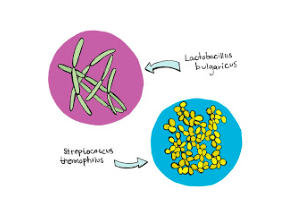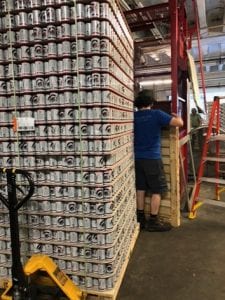Yogurt is a semisolid food product of milk, after being fermented by added bacteria cultures. Yogurt is an easy way to obtain probiotic cultures, which improve lactose digestion, gastrointestinal functions, and stimulate the immune system. Humans and bacteria have a mutualistic relationship; both parties are entirely different but benefit from the relationship. There are millions of bacteria living in the inside and outside of us all!
The most popular bacterial yogurt cultures used are Lactobacillus bulgaricus and Streptococcus thermophilus. The function of the bacterium is to ferment lactose, which is milk sugar, to produce lactic acid as a waste product. The increase of lactic acid present will decrease the pH of the milk, causing the liquid to clump and form yogurt.
The production of yogurt starts by adjusting the milk composition and adding the needed ingredients. Milk composition is adjusted to attain the preferred fat and solid content. In some cases, dry milk is added to increase the amount of whey proteins. The milk mixture is then pasteurized at 85°C for 30 minutes or 95°C for 10 minutes. The increase in temperature will denature the whey protein; this will allow the proteins to form stable clumps. This prevents dissociation of the water and solid product during storage.
After being pasteurized, the milk mixture is homogenized to include the added ingredients entirely and improve the consistency. The milk is cooled at 42°C, which is an ideal temperature for Lactobacillus bulgaricus to grow. The milk is pasteurized before the cultures are added to ensure they will remain lively to act as probiotics. The yogurt will be held at 42°C until the pH has reached 4.5. This allows Lactobacillus bulgaricus and Streptococcus thermophilus to ferment the sugars present continuously. Fermentation is an anaerobic process, in which the final electron receptor is exchanged for another molecule. This process produces fermented end products such as lactic acid and ethanol. During the fermenting process, the milk will visibly clump together and start to resemble yogurt. After several hours of fermentation, the yogurt is cooled to 7°C to stop fermentation. Once the yogurt is completely cooled down, fruits and different flavors are added before packaging. Lactobacillus bulgaricus performing fermentation is a crucial step to yogurt production as well as other healthful foods.
Sources:
http://www.milkfacts.info/Milk%20Processing/Yogurt%20Production.htm
http://science.jrank.org/pages/710/Bacteria-role-bacteria-in-fermentation.html
https://prezi.com/aarmqkmdu_xf/human-and-bacteria-mutualism/










